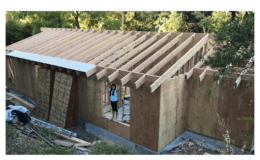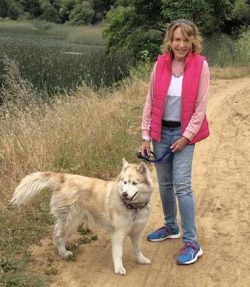Thanks so much for this thoughtful account! Planning to attend Wednesday night’s meeting.
End game is near in Daughtrey’s redevelopment, but where is community input?
- By : Peter Rosen
- Category : Community, Featured Story, Local Control, Town Square


The format of Wednesday’s special Municipal Advisory Council (MAC) meeting to discuss the redevelopment of the Daughtrey’s building in the heart of our downtown is the only opportunity for Castro Valley to comment before the developer is selected.
This one meeting is a missed opportunity for the robust public input needed to define a vision for a site that is a crossroads of Castro Valley’s past and future.
The draft Request for Information (RFI) that will be discussed on Wednesday essentially defines the vision for the site.
This meeting is not what I had hoped for. There has been very little discussion and public outreach about the site since David Greensfelder’s “Lost Worlds” project was rejected last December.
It is disappointing that there won’t be another chance for the people of Castro Valley to review the document that will be used to solicit development offers for the site. If the goal is to have the community participate in the refining of the RFI, then there should be more opportunity for public engagement at meetings and workshops.
The community should have plenty of notice about these public meetings – not just two weeks – and they should be widely advertised and thoroughly promoted.
I believe that the format of a typical MAC meeting limits the opportunities for a productive back and forth discussion. The MAC meetings are run and directed by the MAC, and the public has a very limited role in the discussion. Given the lasting significance of this project, our community deserves a more flexible “town hall” style format that would allow greater public input and creative brainstorming among community members.
Even this additional opportunity for public review is highly unusual, according to Eileen Dalton of the Alameda County Economic and Civic Development Department (CDA). According to Dalton, it is not typical for the public to review a draft RFI before the County solicits bids and risks “meddling.” Alameda County is “not going to proceed with a proposal that does not have the support of the community,” Dalton said. CDA is holding this meeting to determine whether they have captured accurately what the community wants. They are looking at upscale restaurants and retail in response to what people have been telling them.
Best Use of the Site
The goal should be to identify the best use for the site, and then find the funding for it.
Keep in mind – the public owns this property. The property’s redevelopment should benefit the public. This is not a typical real estate transaction. If the property is sold for $2 million, Castro Valley will not see any of this money.
When T.J. Maxx moved into the village, the County’s Assistant Director of Economic Development at the time, Bill Lambert, was very proud that the retailer would generate about an additional $160,000 per year in property and sales taxes. I asked if that meant that we would see more Sheriff patrols, sidewalks, better roads…anything to directly benefit Castro Valley. This is when I learned that we get no monetary benefit from Alameda County for additional revenue. We need something that will help businesses and residents of this town instead of a single developer.
Eileen acknowledged these concerns and pointed out that the best use of the site is what is most important, which is why there is no price listed on the RFI. To their credit, the CDA appears to be more concerned about what will happen here, and how it will make downtown Castro Valley successful, than how much money the County will receive for the property. This is not a real estate development with a price attached. It is about compliance with public goals and community support. The CDA is using this desirable asset (the site) to create a public/private partnership for achieving those public goals.

Rushed Process
I was very happy to learn that the process to update Castro Valley’s Downtown Specific Plan is finally beginning this year. Before it was shut down, Alameda County’s Redevelopment Agency had the wisdom to recognize that the Daughtrey’s building was a critical piece of our downtown. This is why it was willing to pay so much for it (nearly $2.8 million in fact). I believe that it would be shortsighted to move forward without incorporating the vision and direction that the new Specific Plan will provide our community for Downtown Castro Valley.
I mentioned this to Susan McCue, the Alameda County Economic Development Manager, and she said that the Specific Plan Update could take two years, and that people want something there now. I don’t see the need to rush, and I would rather get it right than see another unsuccessful project be presented.
According to Dalton, this process is being fast-tracked because there is so much interest in the site, without even advertising. Her department is responding to the opportunity and believes it is really important to capitalize on this. She is worried that the interested parties will lose interest if we delay the process. “No way” was her response when I asked her if they would be willing to wait for the Specific Plan Update or a more robust community outreach process. She is excited because they have received several unsolicited bids from “unique, highly qualified, development interests. There are multiple possibilities that can work to activate the downtown.”
I believe that we should emulate the thoughtful, deliberate community outreach efforts that were successful in the pursuit of the new library. If anything, the last experience with David Greensfelder and the Lost Worlds fiasco indicated to me that extra effort should be made to ensure that something is selected that has strong support from the community. In addition to some great information, (that is referenced at the end), the report includes examples of engaging with a wide range of groups in Castro Valley, comprehensive surveys, community workshops, and a conclusion that clearly points to the need for a new library.
Castro Valley needs more public meetings and engagement than this single MAC meeting to create a vision for the Daughtrey’s site. Dalton pointed out that there will be many opportunities to comment in the future – this is also pointed out in her memo to the MAC. After this MAC meeting, CDA will solicit bids, create a matrix that includes a summary of the proposals and, from this, CDA would select a preferred developer. At that point, they will execute an exclusive negotiated agreement, and they anticipate it will move forward. All of this information will be shared with the public and, in the event that the project does not meet the goals and requirements stated, there are safeguards included that will allow the CDA to back out of it and ensure that it gets back on track.
Many of the community members I have spoken to believe that the Daughtrey’s building itself is holding back the process. There is greater support now to tear down the building than when Greensfelder was officially selected as the developer in 2014. If the goal for the site is successful restaurants and retail, then a new, smaller building is much more desirable. As was confirmed when Lost Worlds was being proposed, about a third of the current building will have to be left unused because of the permitted number of parking spots associated with the development.
Removing the building does not appear to be an option that is being considered. At the Lost Worlds presentation, most of the speakers voiced their desire to take the building down. If the goal is increased parking opportunities, the building needs to come down. If we want retail and restaurants, but we cannot use a third of the existing building because of the number of parking spaces allocated to it based on the building’s square footage, the building needs to come down.
If we want a town square, the building needs to come down. One option that has received a lot of support from people I spoke with is a flexible use space that could provide parking most of the time, but could also be used for food trucks, farmer’s market, summer concerts, etc. None of the recent interested parties have wanted to take the building down. All of their plans involve repurposing the space according to the draft RFI, and they are willing to work within the parameters spelled out.

The future of Our Downtown
In a perfect world, we would still have the resources and commitment that the Redevelopment Agency had five years ago to help develop and energize our downtown. We don’t.
The only public resources we have to revitalize downtown Castro Valley are this building, the location, and the surrounding shared parking project. The fact that there are multiple developers interested in the site should indicate how much potential this location holds for success. This extra interest does not mean it should be rushed. On the contrary, it gives even more reason to wait for the visioning of the new Downtown Specific Plan, and the community analysis of needs and desires.
After reading the draft RFI and speaking with Dalton, I can see the potential for success here, but I also remember what has happened in the past. This is why I have pushed so hard to tear down the building. I hope that this time we have a different result, and we can have a space that will energize and activate our downtown. I would rather we have a public space and increased parking downtown, but the developers who have looked at the building insist that they can modify the structure to take advantage of all the location has to offer. If they are right, and they can attract upscale restaurants and a space that draws people in, we all win. In order to do this, the community needs to stay diligent and stay on top of this process. We will need to scrutinize the development proposal and, as the project proceeds, we need to stay involved.
The CDA is hoping that the community recognizes that the valuable opportunity that exists here and they believe that the need to move quickly overrides the need for community outreach. It is clear that they believe that there are significant risks involved if they slow down the process. They assert that the level of interest and the interested parties are so beyond what was expected, that there is no need to stretch out the process. Dalton insists that this space will, “be the cool place to go downtown”. As a long-term resident who has no plans of moving, this is my wish as well.
Your voice matters in determining the future of the Daughtrey’s building site.
- Make sure to be at the MAC meeting this Wednesday at 6:00 p.m. at the Castro Valley Library. CVM plans to broadcast the meeting live on our Mixlr channel.
- Make a comment at the meeting. Here’s CVM’s guide on how to make a public comment.
- Send a note to each MAC member, the Community Development Agency, and Supervisor Miley’s office (c/o Tona Henniger, Matt Turner, and Paul Sanftner):


